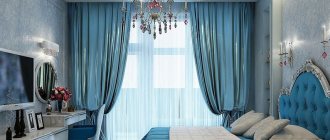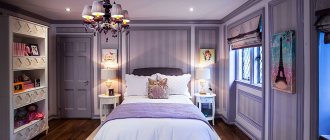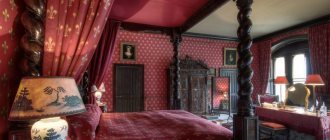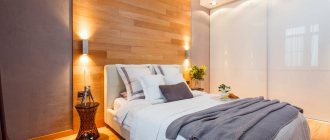[ads1] Japanese design is often called an ethnic version of minimalism. Restraint and simplicity of design are ideal for small-sized premises, where the majority of Japanese residents live, because this country has a high population density. This design is also suitable for bedrooms in our city apartments.
A bedroom is a room intended, first of all, for complete and comfortable rest. In this room, homeowners try to find refuge from everyday worries and anxieties.
Residents of Asian countries have long realized that in order to create a calm atmosphere it is necessary to eliminate distractions and details that overload the interior.
A relaxation room, decorated in Japanese style, will turn into an island of calm and give residents peace.
Signs and general concept of style
Mysterious and original Asian traditions have always inspired interior design specialists to come up with original ideas. Merging with the natural world, lightness and the effect of spaciousness, naturalness - this is how one can characterize the Japanese style.
Philosophers have always sought to find a balance between yin and yang, the elements of air and earth, light and dark. All this is reflected in the contrasting combination of shades of traditional Japanese design. The most popular color combinations are wenge and beige, snow-white and black.
To decorate a bedroom in a Japanese style, you need to follow the following principles:
Minimalism . The spacious room creates a microclimate that promotes the achievement of physical and mental harmony. The strict configuration of furniture and the rejection of unnecessary decorative elements set the mood for relaxation. In such an environment it is easy to forget about worries.
Naturalness . The closeness to the natural world is emphasized through the use of environmentally friendly materials of natural origin:
- wood;
- linen and cotton fabrics;
- bamboo;
- vines;
- rice paper;
- reed
Naturalness is also manifested through natural shades: cherry, emerald, chocolate.
Functionality . Arranging the room with comfortable shelves, cabinets of a simple design, and built-in cabinets with sliding doors helps to rationally organize the space.
Important! The use of natural materials and adherence to the principles of minimalism are the main features of the Japanese style.
Basics of Japanese style
Different climatic conditions and layouts of residential premises between the CIS countries and Japan do not allow achieving 100% authenticity in the interior design.
But following the four basic rules that lie in creating a Japanese style will allow you to bring your bedroom as close as possible to the Eastern philosophy of comfort.
Minimalism - only what is necessary and nothing superfluous. Style will not tolerate massive and useless things that needlessly clutter up space.
Functionality is a branch of minimalism. Every element of the interior has a benefit, otherwise it has no place here. It is customary to keep a chest in the bedroom where the mattress is stored after sleep. The cabinet is small, for the most important things, adapted to the design of the room and is not noticeable to the eye. An abundance of lighting fixtures is welcome.
Natural, natural materials - from start to finish, the furnishings are created exclusively from natural raw materials, be it decoration, furniture or textiles.
Read here: Chocolate bedroom - photo examples of bedroom design in chocolate tones
Compactness – the ability to instantly and easily transform a room by moving furniture. This condition is carefully observed in Japanese apartments, since they do not tend to have large footage. If necessary, the bedroom becomes a living room or dining room.
Color palette
If you want to recreate the Japanese style in your bedroom interior, avoid colorful colors and eye-catching color combinations. Calm pastel shades should dominate. The most successful tones are cream, light gray, white and beige.
Black color will help complement the interior and place accents.
But taking into account the differences in mentality, it is very difficult to arrange an authentic Japanese bedroom in a European home. Therefore, in the bedroom interior a combination of not only classic Japanese shades, but also a number of others is allowed.
The desired colors are integrated into traditional Japanese color schemes with care. The main goal is to achieve harmony and avoid diversity.
The decor of the room should use identical or similar shades that complement the dominant color.
Beautiful ideas for decorating a bedroom interior in the English style: examples of luxurious furniture and expensive finishes - in the photo gallery.
For a selection of photos of eco-style bedroom interiors, see this article.
Asian style bedroom
Principles of Chinese interior
- Harmony.
Chinese interior design should not turn a room into a museum piece telling the story of the Qing Dynasty.
Since we live here and now, it is quite enough when arranging the bedroom to use only a few bright techniques. For example, add typical decorative elements to the decor or buy a couple of characteristic pieces of furniture that will allow you to recreate an interesting decor completely in the Chinese spirit. Remember, the interior of your bedroom should not be an exact imitation of Chinese traditions. First of all, you should be comfortable in such an environment, so if you don’t like a certain shade or decorative element, feel free to remove it from the composition.
minimalist bedroom interior in Chinese style
- Color solutions.
“Add gold painting, the shine of lacquered surfaces and intricate wood carvings, and you will transform your Asian-style bedroom into a jewel box.”
In Chinese culture, color has symbolic meaning. However, this does not cancel the first principle: if we don’t like it, we don’t use it! For an Asian-style bedroom with a Chinese twist, any combination of the following colors is suitable:
- black;
- beige;
- red;
- gold.
You can also include green, yellow and blue here; in general, as you can see, almost the entire palette is listed. And if you start studying photos of bedroom decors made in the Chinese style, you will not be able to help but notice the variety of color options. Moreover, for a Chinese interior, the actual presence of color is more important, and not the combination of shades.
combination of red gold and beige in a bedroom decorated in Chinese style
If you want to make your bedroom respectable and especially sophisticated, use red and black colors in your decor. Add to this gold painting, the shine of lacquered surfaces and intricate wood carvings, and you will turn your Asian-style bedroom into a precious box. It will be perceived quite loyally if there was a sense of moderation in the design development.
If you need a bedroom with a calm atmosphere, it is better for you to choose a combination of white or beige and brown for decor. They are also good to combine with delicate blues and shades of olive.
- Quality vs Quantity
This excellent principle will allow you, without cluttering your bedroom with unnecessary details, to clearly draw a line of Chinese style in its interior. You can buy a matching bed and nightstand, or add an expensive element to your decor, such as a jewelry box, a hand-woven rug, or rich curtains.
functional furniture in the Chinese style bedroom
For room decor, try to select items that are similar in style and color, including Chinese-themed details.
This principle also applies to the choice of bed linen, the quality of which can also be amazing, or a mattress for your favorite bed. These details are by no means unimportant. They directly affect the quality of your rest and satisfaction with life in general, so it’s better to save on something else when decorating a bedroom in an Asian style.
- Symmetry in Chinese
Chinese philosophy reveres symmetry. This is reflected in local interiors. When placing the bed in the center of the wall, be prepared to surround it on the sides with bedside tables, spaced at the same distance from the walls adjacent to the sides. The issue can be resolved in another way. Use one cabinet in the decor, but place two symmetrically displayed vases on it. You can transfer the symmetry to the wall. Pictures arranged accordingly may appear above the cabinet.
symmetrical placement of furniture in a bedroom decorated in Chinese interior style
- Chinese bedroom decor
It's time to talk about what elements make sense to add to the decor to emphasize the presence of Chinese style in the room.
The most characteristic element will be bamboo. This can be either a real plant or its design applied to the wallpaper, door leaf or cabinet doors present in your Asian-style bedroom. The bamboo theme can be added to the roller blinds.
The use of labyrinths in decoration is very symbolic for the Chinese trend. For example, a closet that has many drawers and shelves of different sizes and volumes can become a labyrinth. They can be randomly placed inside and together create a labyrinth pattern. In this spirit, you can make a headboard for the bed, decorating it with shelves according to the same principle.
decor of the headboard in the interior of a Chinese bedroom
Use geometric patterns in your decor. They can be carved onto bedside tables.
And, of course, a Chinese interior is simply unthinkable without hieroglyphs. They perfectly indicate the Asian theme of the setting. However, before you paint them on walls or apply them to screens, be sure to familiarize yourself with their meaning. In the bedroom decor you need to draw signs denoting love, health and strength.
In an Asian-style bedroom, the symbolism of the sun must be present . You will find solar cells in both Chinese and Japanese decor. They can be either lamps with round lampshades or a round carpet. These can be simply decorative elements and semicircles in furniture lines. It’s easy to give this shape to the headboard or bedside tables. Solar details bring with them good luck and strength. This is a symbol of real power and it can appear not only in the break room.
a chest of drawers and vases will add color to the Chinese style of the bedroom interior
- Bed for Chinese interior
The bed in the Asian interior needs to be discussed separately.
Usually it is gigantic in size and installed on a podium. The bedroom is very reminiscent of an imperial boudoir. You can equip your bedroom, interpreted in Asian style, with a tatami bed. This is a mattress laid on a low wooden frame, which necessarily protrudes beyond its boundaries. Tatami came to the Asian style from Japan. There they were mats that lined the floor. Years passed, and Asian culture transformed, adapting to the spirit of the times. It was replenished with traditions of other cultures. If you want to move away from the classics and move closer to modernity, just such a bed will become an authentic filling for the bedroom. And in general, a bed of this type is universal and can be used in an interior of any stylistic orientation.
asian style tatami bed
Principles of Japanese interior
General characteristics
Several details will help you make your bedroom interior akin to Japanese. Why akin? Because making a bedroom in the traditional Japanese way is simply not within our capabilities. In addition to the fact that our climatic aspects do not coincide, we also have different approaches to creating a dwelling in principle. But we are quite capable of making a bedroom in an Asian style recognizably Japanese.
Japanese minimalism
Japanese interior attracts attention with its ascetic decor. There are a minimum of items here, and those that are present are not at all cumbersome. The subtlety of the situation is that in the absence of everything superfluous, such a bedroom should have everything necessary for a comfortable rest. Compliance with this rule is important, as it ensures the movement of positive energy flows, revered by the Japanese.
minimalist bedroom design in Japanese interior style
Functionality in Japanese
The second sign of Japanese style is functionality. It systematically follows from the first. The minimum of furnishings should be compensated by their spaciousness and design specifics. In the bedroom of a true admirer of Japanese culture there should be a chest in which a futon and a wardrobe for the necessary things will be hidden during the day. A bedroom in this type of Asian style should be sufficiently lit.
Natural finish
The entire decor of such a stylish bedroom should be reproduced only from materials given by nature. This applies to furniture, textiles, and decoration in general.
using natural materials to decorate a room in Japanese interior style
Mobility of the situation
A Japanese-themed bedroom should be able to be quickly transformed. This tradition is a product of the small size of Japanese homes. Often in them the functions of a bedroom, living room and dining room were performed by a single room.
Color modifications
Japanese style does not accept variegation and poisonous colors. The color palette of an Asian-style bedroom should be discreet, calm and natural . What shades are in demand?
- Grey.
- White.
- Beige.
- Cream.
Black color may well appear in the decor, but there should be very little of it, and its task is to emphasize the main combination.
Japanese style bedroom in beige color
Of the undesirable colors, shades of mahogany, as well as the chocolate palette, are especially distinguished. But this is only for those decors where they try to accurately reproduce the Japanese atmosphere. Its modern stylizations can contain any colors that are pleasing to the owners.
The absence of variegation is achieved by choosing one primary color, which is made the background; everything else: curtains, furniture, decoration is maintained in the selected shade. To fill the interior with aesthetics and harmonize it, contrasting shades are introduced into the decor.
Subtleties of bedroom decoration
“There should always be an abundance of lighting in an Asian-style bedroom so that every corner is illuminated.”
The floor in an Asian bedroom should be made of wood. Modern technologies make it possible to imitate it and this is quite acceptable. The covering can be bamboo laminate. If desired, the floor can be decorated with a real Japanese mat. In Japanese culture, this imitation carpet is called tatami. If you use a mat in an Asian-style bedroom, do not forget that it must be replaced every six months.
wall painting in a Japanese bedroom
The walls of Japanese homes are often sliding screens, which are constructed from wooden frames and rice paper. In our vision, they may well be replaced by wooden panels and wallpaper with traditional patterns. You can cover the walls with fabric, but only natural and always monochromatic.
The ceiling should not look massive either. In this regard, it is often made tensioned, using a matte monochromatic film, or a suspended structure is assembled from frosted glass, behind which the backlight will be hidden.
traditional fans as an element of wall decor in a Japanese bedroom
By the way, there should always be an abundance of lighting in an Asian-style bedroom so that every corner is illuminated. However, this does not mean at all that the light streams should be bright; on the contrary, the flowing light should resemble moonlight. Floor lamps and sconces, the lampshades of which are decorated with traditional ornaments, do an excellent job of this task.
The windows are decorated with Japanese or almost identical in principle, Roman blinds.
Furniture
In a Japanese bedroom there is only room for furniture with geometrically clear proportions, simple lines and a smooth surface.
All furniture in the bedroom should be very low. Looking at the bed, it should appear as if the mattress is lying directly on the floor. Japanese-style sleeping platforms are very popular among consumers today.
option of placing the bed on the podium
Low bedside tables may appear near the bed, but closets should be veiled. Niches can fulfill their role. Only shelves on which modest decorative elements and lamps are displayed are allowed to protrude on the surface of the walls.
An Asian-style bedroom is unusual and mysterious. Here, every object has meaning, and its “emptiness” is omnipotent. Such an interior is conducive to self-discovery. If you like all this, then Asian style should be your choice!
Wall decoration
Traditional Japanese houses have no walls. Previously, housing was divided into rooms using mobile partitions made of wood or rice paper. Today, screens are used primarily for decorative purposes to divide a room into zones that differ in functionality.
Changing the living space is the optimal solution for small bedrooms.
The main surfaces in the bedroom should be decorated in light colors. The following materials are suitable for wall decoration:
- Bamboo-based wallpaper : with their help you can create exquisite decor. Instead of bamboo canvases, you can use paper ones with ethnic-themed patterns (with Asian hieroglyphs, cherry blossom branches, flying birds).
- Wood panels . Wall cladding with wood panels that imitate sliding partitions looks elegant.
- Bamboo is an ideal option for natural decoration. This plant symbolizes Japanese culture.
- Natural textiles . A room with walls covered with natural monochrome textiles looks cozy and presentable.
- Dye . The walls can not only be covered with wallpaper, but also painted in a light shade. Patterns are often applied on top of such a coating using stencils.
Ceiling
The ceiling in a Japanese bedroom should have a rectangular configuration. The shape and individual details can also be square - these are the traditions of Asian culture.
The design is done using natural materials. Despite the fact that artificial materials can also be used to decorate the ceiling, it is better to give preference to fabric or wood.
The color palette is only light. Many decorate the ceiling and walls in a single color scheme, using light natural tones. Discreet patterns are allowed.
In Japanese bedrooms, beam and suspended ceilings are most often designed. In the first case, the surface is divided into square or rectangular elements by beams fixed to the painted ceiling, and then the ceiling is covered with textiles or paper.
Tension structures on a profile made of metal or plastic are fixed on a fabric or film panel.
The Armstrong system, which is a structure consisting of profiles and decorative plates, is also popular.
The larger the sections on the ceiling in the room, the more spacious the bedroom will seem. It is important that the lintels contrast with the ceiling; they are designed from dark wood or wood-imitating materials.
Adding Natural Elements
One of the most basic motifs that can almost always be found in an Asian-style room is nature. This could be, depending on your preferences, landscapes, flowers or animals. Place small sculptures or collectibles, various plants or natural materials. Overall, adding natural elements to a room will create a feeling of peace and harmony in the space. A magnificent traditional painting with birds and flowers will probably be one of the most successful options.
Won the Green Card lottery, moved to the USA and opened a profitable business
I turn popsicle sticks into convenient toaster tongs: the technology is very simple
The son is handsome, and the daughter is a copy of her mother. Yulia Menshova showed photos of children
Flooring
Great attention is paid to the design of the flooring in the bedroom. In eastern countries people walk around barefoot at home, and a comfortable heated floor for the bedroom is especially important.
Wood covering is considered the best choice, but it will not be cheap. An alternative can be parquet boards or bamboo-based laminate.
Be sure to lay mats made of natural materials on the floor: rattan, bamboo or light-colored wooden matting. The disadvantage of such rugs is their rapid wear.
A rug in neutral colors or with oriental patterns placed next to the bed will last much longer.
Attention! Natural wood flooring fits best into the Japanese interior concept.
Decoration of window openings
[ads2] In classic Japanese houses there were no concepts of window and door openings - they were replaced by mobile partitions. To decorate the windows in a Japanese bedroom in an apartment located in a European country, a special type of blinds is used - Japanese curtains, which are panels made of fabric. Such structures are fixed on a cornice consisting of several strips and are weighted from below.
To make Japanese curtains, translucent or semi-transparent natural textiles (cotton, linen) are used. Such curtains give the room lightness and visually make it more spacious.
Panel-type blinds come in monochrome and decorated with national designs. Curtains made from jute and bamboo straw look impressive.
The larger the window opening, the more harmonious the screen-like curtain looks. For narrow openings, vertical fabric blinds are more suitable.
Doors
Sliding door panels are used in Japanese interiors. Such doors emphasize the eastern orientation of the design and save space.
In their homes, the Japanese install doors with the original name “shoji”, which are a glazed frame made of wood, perpendicularly divided by slats into square or rectangular elements.
The most popular are white glass doors and colored frosted glass. Dark types of wood are used to make the frame. Structures made of cherry, pine or walnut are veneered and tinted.
The advantages of such doors (regardless of whether they are folding or sliding) include compact size, convenient operation and noiselessness. The only downside is poor sound insulation.
Read about how to arrange a functional bedroom interior in a loft style and see photos of options for modern bedrooms in an industrial style.
Read about the features of implementing shabby chic style in a bedroom interior here.
You can view a photo gallery with chalet-style bedroom design ideas in the article at:
Bedroom: what you need to know
The use of Japanese-style wallpaper in the bedroom is very common. It should immediately be noted that in this case, you need to select suitable colors, since they must be in harmony with the overall decor. As for the choice of colors, as a rule, soft, almost pastel colors, such as cream, sand, beige, etc., are optimal. In addition, we must remember that you can use companion wallpaper, combining them harmoniously and giving the room even more originality.
Related article: How to hang curtains on sloping windows
When decorating a bedroom, you need to remember the need to properly decorate not only the walls, but also the ceiling of the room. Please note that the presence of various decorative elements is very welcome, be it small figurines made of natural wood, paintings or panels with ethnic motifs, or even souvenirs brought from Japan.
On a note! An important condition is the presence of images of sakura on the wallpaper. You can also use it on additional decorative elements, such as photos with frames, paintings or home textiles (pillows, blankets, rugs).
Alternatively, you can draw sakura yourself using a stencil, or even use special vinyl stickers. Despite the low price, they are distinguished by their attractive appearance and ease of installation. All this allows you to significantly transform the interior of your bedroom, or any other room in your apartment or house, be it a kitchen, living room, corridor or even a hallway, in a short time.
By the way, about textiles. The correct combination of wallpaper with colors and curtain patterns is extremely important. That is why curtains must be selected with special care so that they are in harmony with the rest of the room.
Light
When creating a bedroom interior in Japanese style, you need to take care of good lighting. During the day, the maximum amount of natural light should enter the room. With the arrival of twilight you will have to use artificial light sources.
Lighting devices should have a laconic and unobtrusive design.
Dim lighting helps create a mysterious atmosphere that encourages relaxation and good rest, and relieves stress. Matte lamps, bamboo or paper lampshades that scatter light rays will help you design such a lighting scenario.
Refuse floor and table lamp models - they do not meet the requirements of minimalism. Lighting devices mounted on the ceiling will help to distribute lighting evenly, without creating sharp transitions between light and shadow.
For a Japanese interior, you need to choose lamps with a simple geometric configuration. The most popular models are white and black.
Yellow and brown lighting fixtures are appropriate in such an environment. The main thing is that they are made from natural materials. Bamboo, glass and wooden light sources, rice paper products are perfect for such an interior.
On a note! Lighting devices designed in the appropriate style will emphasize the colorful design of the room, but you need to take into account that such elements visually compress the space.
In small rooms, it is better to use lamps with LED bulbs and spotlights for lighting.
Colors and materials
In fact, the Japanese almost always use only earth colors in their interiors. Opt for one light shade, highlight the outline with a dark color, add a little liveliness in the form of an accent tone, and a Japanese bedroom design will never look boring.
So, you can safely use:
- Beige.
- White.
- Sand.
- Pink.
- Burgundy.
- Cream.
- Red.
- Cherry.
- Sunny yellow.
- Olive.
- Gray to black.
Visual instructions for Japanese interior design.
A Japanese-style interior will look authentic if you use the following materials:
- Concrete.
- Stone.
- Nacre.
- Tree.
- Bamboo.
- Jute.
- Rice paper.
- Brick.
- Plaster.
Advice! Natural materials can be quite expensive, so try replacing them with their analogue. The special spirit of naturalness will not manifest itself so clearly, but only you will know about it.
Furnishings
In bedroom interiors, for which Japanese style is chosen, attention is focused on one piece of furniture - the bed. Residents of Japan sleep on low double beds with a wide rectangular bed.
You can purchase a solid wood bed with a podium or small legs. Complete the bed with low side tables and a small table for tea parties.
Don't clutter your bedroom with a large closet. It is recommended to store things in niches equipped in the walls and built-in wardrobes.
Of the protruding elements on the walls, only small shelves are permissible.
All furniture must have clear lines; decorative details such as carvings and forgings are unacceptable.
Set of integral elements
Fusuma
The function of partitions and swinging European interior doors is performed by sliding screens (fusuma). Installed in the upper and lower guide grooves, they move like sliding doors, which significantly saves space indoors.
The ease of moving the panels allows you to change the layout according to the needs of the owners at any time. If necessary, fusuma divide a large room into additional rooms. According to one version, the word fusuma is an ancient synonym for the Japanese bedroom.
A bedroom without a screen cannot bear the proud name of a Japanese-style bedroom. The choice is unimaginably large, but it is better to prefer the authentic versions. Delicate, subtle designs adorned with calm, detailed depictions of flora and fauna.
A worthy option is a handmade wicker screen (bottom photo).
Tatami
Geometry is observed both in the structure of the walls and in the schematic floor covering. Designed for quick, convenient assembly and disassembly, folding, folding.
The Japanese cover the floors of living quarters with rectangular light green mats - tatami. Peculiar reed mats stuffed with pressed rice straw and trimmed along the edges of the long sides with black fabric (top and bottom photos) are the quintessence of Japanese style.
There are rules for placing tatami in a room according to a certain pattern.
The natives of Japan are convinced that the wrong location of the tatami brings misfortune to the house.
The four corners must not be allowed to converge. Keep this in mind when designing your Japanese bedroom.
The size of the mats is 90x180x5 cm, they also measure the area of the rooms. Tokyo tatami are a little narrower (85x180 cm). There are also small deviations from generally accepted sizes in some areas or (rarely) a smaller version of 90x90cm.
Tokonoma
An inseparable element of the Japanese interior is a niche in the wall, visually highlighted by a low podium (clearly visible in the top two photos). A kind of sanctuary in which the most precious things for the owners are located. Often the tokonoma area is a bedroom; a bed is placed on the podium.
Traditionally, a scroll with a wise saying or motto chosen by the family is hung on the wall of the tokonoma. It could be a Japanese print or a poem. A small flower arrangement (ikebana), sometimes an aroma lamp with incense, is placed on the floor.
Futon
The cotton mattress on which the Japanese sleep is called a futon. In the evening, a Japanese bed is laid out, rolled up in the morning and put into a closet for storing bedding. Here, in fact, is the entire Japanese-style bedroom (photo).
Most adherents of Asian philosophy are still not ready to spend their nights on the floor. When choosing a bed for your Japanese bedroom, remember - the lower, the closer to authenticity. The market is flooded with a huge number of podium beds with “Japanese” styling.
Accessories
Decorative elements in a simple and functional bedroom interior, designed in Japanese style, are used in small quantities. Accessories should be expressive and laconic. Shelves and niches can be decorated with scented candles, traditional figurines, porcelain plates with dried flower petals.
A vase placed on the floor, decorated with national Japanese ornaments, with bamboo branches or an unusual hand-made ikebana, will transform the room.
If you love indoor plants, decorate your bedroom with a dwarf tree - bonsai.
Original decorative elements will include fans, parchment sheets with hieroglyphs, samurai swords, and paintings with Japanese landscapes.
Creating Harmony
To create a relaxing and calming atmosphere in your room that will help you sleep better and meditate, use Zen philosophy. Soft, neutral colors were the main theme for the interior, but brighter shades of red, yellow and black were used as accents. In addition, several different natural elements were also added to the bedroom: indoor plants, botanical-themed artwork, and botanical-themed bedding.
A hotel in England sheltered a man for free, and he repaid the kindness.
A designer friend told me the basic rules for choosing beautiful curtains for your home
The hunter experienced the most exciting journey at the age of 92: he got lost in the forest
Who is suitable for Japanese design?
Japanese design is based on minimalism, so such interiors will appeal to connoisseurs of this trend.
This design will appeal to convinced ascetics and people leading a modest and quiet lifestyle, residents of megacities who are tired of the rush and frantic rhythm of life, and supporters of impeccable cleanliness.
The Japanese style is preferred by philosophers and all those who are interested in Eastern culture.
A bedroom interior, decorated in calm colors, with a minimum number of pieces of furniture and decorative elements, will give you the opportunity to plunge into the mysterious oriental atmosphere. This design is perfect for decorating small bedrooms; it does not require much space and looks very original.











